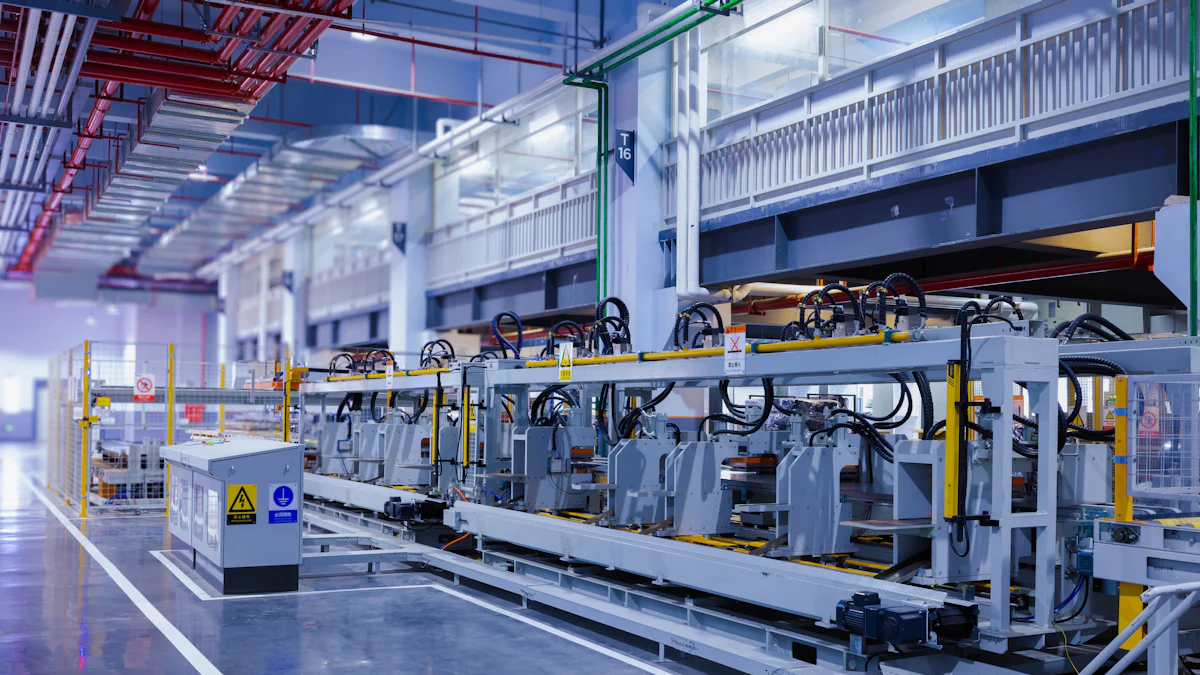Maximizing Security and Efficiency with Advanced Automation

Security and efficiency play a vital role in modern operations. Businesses face constant threats and need to adapt quickly. Automation steps in as a game-changer. Automation not only boosts productivity but also enhances security. Imagine reducing security threats by 70%. That's the power of automation. More than 90% of workers report increased productivity with automation tools. Use Automation to streamline processes and cut costs. Automation saves time and reduces errors, allowing employees to focus on strategic tasks. Embrace automation for a more secure and efficient future.
Understanding Advanced Automation
Definition and Scope
What constitutes advanced automation?
Advanced automation involves using cutting-edge technology to perform tasks with minimal human intervention. This type of automation goes beyond simple mechanization. It incorporates intelligent systems that can learn and adapt. These systems often use artificial intelligence and machine learning. Advanced automation can handle complex processes efficiently. Businesses can rely on it for tasks that require precision and speed.
Key technologies involved
Several key technologies drive advanced automation. Artificial intelligence plays a crucial role. AI enables machines to make decisions based on data. Machine learning allows systems to improve over time. Robotics brings physical capabilities to automation. Robots can perform repetitive tasks tirelessly. The Internet of Things (IoT) connects devices, enabling seamless communication. Cloud computing provides the necessary infrastructure for data storage and processing. These technologies work together to create powerful automation solutions.
Historical Context
Evolution of automation technologies
Automation has come a long way since its inception. The journey began with the invention of the Jacquard loom in 1804. This loom used punch cards to control weaving patterns. The term 'automation' was coined in 1946 in the automobile industry. This marked the increased use of automatic devices in production lines. In 1969, the first practical programmable logic controller, the Modicon 084, replaced large relay panels. This innovation revolutionized factory automation.
Milestones in automation advancements
Several milestones have shaped the landscape of automation. The development of electronic autonomous robots by William Grey Walter in 1948 demonstrated early robotic capabilities. The introduction of the Honeywell TDC 2000 in 1975 marked the beginning of commercial distributed control systems. This system featured digital communication between controllers and workstations. The personal computer's debut by IBM in 1981 broadened applications for industrial automation. Microsoft Windows, introduced in 1985, became a staple for automation suppliers. These milestones paved the way for today's advanced automation technologies.
Use Automation to Enhance Security

Security threats constantly evolve. Businesses must stay ahead. You can use automation to enhance security measures effectively. Automated systems detect threats faster than humans. These systems provide a robust defense against cyberattacks.
Use Automation for Threat Detection
Automated threat detection and response
Automated threat detection revolutionizes cybersecurity. Advanced AI and machine learning power these systems. They analyze vast amounts of data quickly. Automated systems identify anomalies in real-time. This rapid detection reduces response times significantly. Companies report a 70% reduction in security threats due to automation. Automated responses handle threats with precision. These systems execute predefined actions to neutralize risks. Automation enhances the overall security posture of organizations.
Reducing human error in security protocols
Human error often compromises security protocols. Automation minimizes these errors. Automated systems follow strict protocols without deviation. This consistency ensures accurate threat detection. Automation alleviates the strain on human operators. Employees focus on strategic tasks instead of routine monitoring. Automated tools streamline incident management. They prioritize threats based on severity. This prioritization allows quick resolution of critical issues. You can improve user experience with automation. Automated systems simplify complex security processes.
Use Automation to Improve Efficiency
Streamlining Operations
Automation can transform how you handle operations. Imagine a world where tasks flow seamlessly. Automation makes that possible. You can streamline workflows and eliminate bottlenecks. Automated systems take over repetitive tasks. This frees up your time for more important work. Employees focus on strategic goals instead of mundane duties. Automation tools help you manage tasks efficiently. You can track progress and make adjustments quickly.
Automation in sales departments shows impressive results. Productivity increases by 14.5%. Marketing costs drop by 12.2%. These numbers reflect the power of automation. You can achieve similar results in your operations. Automation brings consistency and accuracy. You reduce errors and improve quality. Customers notice the difference. Satisfaction levels rise when operations run smoothly.
Cost Savings and Resource Optimization
Automation offers significant cost savings. You can cut down on expenses with efficient processes. Automation reduces the need for manual labor. You save money on wages and training. Resources get optimized with automation. You allocate them where they matter most. Inventory management becomes easier. Automated systems track stock levels in real-time. You avoid overstocking and understocking issues.
Energy consumption also decreases with automation. Systems operate only when needed. You save on utility bills and reduce your carbon footprint. Automation helps you make data-driven decisions. You analyze trends and predict future needs. This foresight leads to better resource allocation. Businesses report a 15% increase in productivity through automation. You can experience similar benefits. Embrace automation for a more efficient operation.
Challenges in Implementing Automation
Technical Challenges
Integration with existing systems
Automation can revolutionize your business, but integrating new systems with existing ones poses challenges. Every system has unique requirements and configurations. Compatibility issues may arise when introducing automation tools. You must ensure seamless communication between old and new systems. A well-planned integration strategy helps avoid disruptions. Testing plays a crucial role in identifying potential problems. Regular updates keep systems running smoothly.
Ensuring data accuracy and reliability
Data accuracy is vital for successful automation. Inaccurate data leads to flawed processes and decisions. You need reliable data sources to maintain efficiency. Data validation checks help ensure accuracy. Automated systems rely on consistent data inputs. Regular audits identify discrepancies and correct errors. You should invest in robust data management practices. Reliable data enhances the effectiveness of automation.
Human Factors
Resistance to change
People often resist change, especially when it involves technology. Employees may fear job loss or increased workload. Open communication helps address these concerns. You should involve employees in the automation process. Training sessions build confidence and understanding. Highlighting benefits encourages acceptance. A supportive environment fosters positive attitudes towards change.
Need for upskilling and training
Automation requires new skills and knowledge. Employees need training to adapt to new technologies. Upskilling programs enhance their capabilities. You should offer workshops and courses to bridge skill gaps. Continuous learning keeps employees updated. Investing in training boosts morale and productivity. Skilled employees contribute to successful automation implementation.
Best Practices for Successful Automation
Implementing automation successfully requires careful planning and execution. You can maximize the benefits by following best practices. Let's explore how to set your automation journey on the right path.
Strategic Planning
Setting clear objectives and goals
Start with a clear vision. Define what you want to achieve with automation. Goals should be specific, measurable, achievable, relevant, and time-bound (SMART). Clear objectives guide the entire process. You will know where to focus efforts and resources. A well-defined plan helps avoid unnecessary complications.
Conducting thorough risk assessments
Identify potential risks before diving into automation. Assess the impact on existing processes and systems. Consider technical challenges and human factors. Risk assessments help you prepare for unexpected issues. You can develop strategies to mitigate these risks. A proactive approach ensures smoother implementation.
Implementation Strategies
Phased approach to deployment
Take a step-by-step approach when deploying automation. Start small and gradually expand. This phased method allows you to test and refine processes. You can address any issues before full-scale implementation. A gradual rollout minimizes disruptions to operations. Employees have time to adapt to new systems.
Continuous monitoring and improvement
Automation is not a one-time effort. Regularly monitor automated processes. Identify areas for improvement. Use data analytics to track performance. Make adjustments as needed to optimize efficiency. Continuous improvement keeps automation aligned with business goals. Stay updated with the latest technologies and trends. Embrace innovation to maintain a competitive edge.
Use Automation to transform your operations. Follow these best practices for a successful journey. Automation offers countless advantages. You can enhance productivity, efficiency, and security. Start planning today for a brighter future.
Case Studies and Real-World Examples
Industry-Specific Applications
Automation in manufacturing
Manufacturing has embraced automation with open arms. Factories now hum with robotic arms and conveyor belts. Machines handle tasks that once required human hands. This shift boosts productivity and reduces errors. Automation ensures consistent quality in every product. Manufacturers save money by cutting down on waste. Energy-efficient machines lower utility bills. The environment benefits from reduced emissions.
Automated systems also enhance safety on the factory floor. Robots take on dangerous tasks, keeping workers out of harm's way. Employees focus on monitoring and managing operations. This change improves job satisfaction and reduces turnover. Factories that adopt automation see a significant increase in output. Customers enjoy faster delivery times and better products.
Automation in cybersecurity
Cybersecurity faces constant threats from hackers and malware. Automation steps in to strengthen defenses. Automated systems monitor networks around the clock. They detect unusual activity and respond instantly. This quick action prevents breaches and data loss. Security teams rely on automation to manage vast amounts of data. Machines analyze patterns and identify potential threats.
Automation reduces the risk of human error in security protocols. Systems follow strict guidelines without deviation. This consistency ensures accurate threat detection. Companies report fewer incidents and faster recovery times. Automation also frees up security personnel for strategic tasks. Teams focus on improving overall security posture. Businesses gain peace of mind knowing their data is safe.
Success Stories
Companies that have successfully implemented automation
Dentsu achieved massive success with automation. The company communicated the benefits clearly. Employees engaged with the new systems enthusiastically. Automation transformed Dentsu's operations. Processes became more efficient and streamlined. The company saw an increase in productivity and a decrease in costs. Employees enjoyed more engaging work and less repetitive tasks.
E/D/E revolutionized document understanding through automation. The strategic rollout enhanced processes significantly. Automation improved accuracy and speed in handling documents. E/D/E experienced smoother operations and better resource allocation. The company saved time and money with automated systems. Employees adapted quickly to the new technology. Training programs ensured everyone felt confident and capable.
Lessons learned from real-world implementations
Successful automation requires clear communication. Companies must explain the benefits to employees. Engagement increases when people understand how automation helps. Training plays a crucial role in smooth transitions. Employees need support to adapt to new systems. Upskilling programs bridge knowledge gaps and boost morale.
Strategic planning sets the foundation for success. Companies should start small and expand gradually. This phased approach allows for testing and refinement. Risk assessments help identify potential challenges. Proactive measures ensure smoother implementation. Continuous monitoring keeps automation aligned with business goals. Regular updates maintain efficiency and effectiveness.
Advanced automation stands as a beacon for future growth. Automation offers enhanced security and efficiency. Businesses can achieve remarkable results. Automation simplifies tasks and reduces errors. Organizations should embrace this technology. Automation can lead to a brighter future. Ethical implementation remains crucial. Companies must consider the impact on society. Automation can redefine experiences. A fair society benefits from responsible automation. You should explore automation further. Implementing automation can transform operations. Start your journey today.
See Also
Enhancing Productivity: Understanding Robotic Automation in Warehousing
Advanced Manufacturing: Dispelling Automation Misconceptions
Automated Tomorrow: Advantages of High-Tech Manufacturing Warehouses
